VAZ-2110 is an additional option and is not included in every vehicle configuration. In fact, the mechanism is quite cheap, easy to install, repair and use, but at the slightest breakdown the car owner faces difficulties. It is not very convenient to check whether the lock flags are lowered before each exit from the car. Much easier by pressing one button on the alarm remote control or turning the key in the cylinder driver's door close all the locks.
Central locking on cars of the tenth family
The main function of the device is clear from the name: it is used to unlock and lock all car door locks at the same time. The operation of this device can be carried out both in conjunction with a car alarm and without it. The basis of the device is a block central lock VAZ-2110, which is a small circuit consisting of several semiconductor elements and electromagnetic relays. Instead of the latter, not relays, but transistor power switches can be used.
Despite all the advantages central control locks, you should not trust him completely, especially if he has been observed to have certain sins. In case of minor failures, one or more locks may not close completely. The reason for this may be a malfunction of the electric motor, the gearbox included in its composition, or the control system. For carrying out even small repair work You need to know the structure and operating principle of the central lock.

Main Components
The central lock (VAZ-2110) has the following components in its design:
- Semiconductor control unit for electric drives.
- Gearmotors act as actuators (there are 4 of them in total - one for each lock, but if there is a drive to unlock the trunk, then five). These are small electric motors with gearboxes on the rotors.
- allowing you to determine the condition of the lock (installed in the gearmotor mounted in the driver's door).
- Wires, connections, fuse.
The VAZ-2110 central lock can operate in several modes:
- All locks are activated when the driver's door is unlocked/locked.
- When arming and disarming a car alarm. Provided that the alarm and central locking control units have been connected.
- If available remote control Central locking from the key fob. Such control systems have quite low cost and can be used on cars without alarms.

The main causes of central locking failures
If it doesn't work central locking VAZ-2110, the reason for this is some defect in the actuators - gearmotors. In the entire structure, they are the most vulnerable point, since they are subject to the greatest load. These devices move during operation, which speeds up the production of the elements included in their design.
But there is one important detail - VAZ-2110 cars were discontinued more than ten years ago, which already suggests that any of the cars will have problems associated with the “obsolescence” of elements. The wiring is destroyed, gear motors become unusable, even transistors in the control unit can fail over such a period due to frequent overheating. Therefore, it is necessary to carefully study all the symptoms of breakdowns and methods for eliminating them.
Central locking activators
It is with their help that the VAZ-2110 central lock is controlled. They are mounted in the doors and have a plastic body. Incidents of meltdown are rare, but they do happen. Especially if the device is subject to a large load or the motor is frequently triggered. In case of a physical defect (melting, destruction), the following symptoms appear:
- On the door in which the defective activator is located, the unlocking/locking function stops working.
- The fuse fails due to excessive loads on the supply circuit.
Causes of activator failures
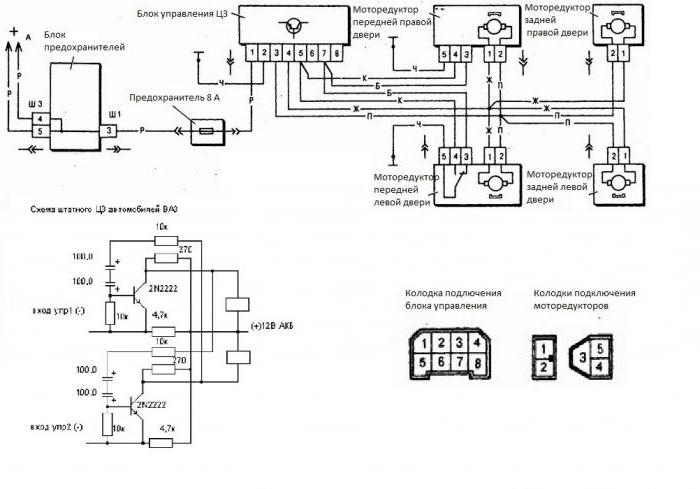
Almost all activator components are made of plastic. It is quite durable and can withstand heavy loads. But there are also defects and lock malfunctions. In the latter case, there is a sharp increase in the load on the motor, the gears can break down and become disengaged. The lock will buzz, but the flags will not go down (or up, depending on the current state).
But such a manifestation of breakdowns can also be caused by incorrect installation. This is only the case if work has taken place relatively recently, directly or indirectly affecting the elements of the central lock. Failure to adjust the rods is the first sign that the entire system will not work correctly. The lock on which the adjustment is incorrect will not work, while the others function properly.
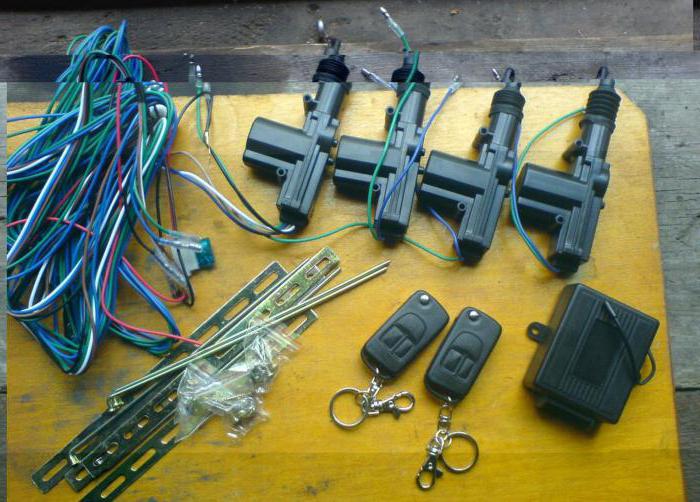
central locking
Every motorist who has at least once encountered it knows where the central lock (VAZ-2110) is located. It is located under the central part of the dashboard, right on the floor. It is quite simple to distinguish it: the block is made of plastic, a wiring harness with a block at the end fits into it. Having removed the cover from the block, you will see a small board inside it. It is this block that is responsible for the functioning of the entire system. And the reasons for its failure may be the following:
- If the activators malfunction or the load on them increases, the current in the power circuit increases. This leads to significant overloads, fuse failure, and destruction of printed wiring tracks. Under prolonged thermal loads, the soldering is destroyed, the mounting legs of the elements lose electrical contact with the entire circuit.
- Age plays big role, therefore, over time, contacts in electromagnetic relays may break down. Transistors do not last forever; they can also fail if overloaded.
- If the fuse burns out, the entire circuit does not work - the central locking does not respond to anything. The fuse is located in a special rubberized or plastic case, in a break in the red (sometimes pink) wire. Please note that you cannot install fuses of a larger rating, as this will lead to melting of the wiring and a fire.
- The plug connection of the control unit is one of the most vulnerable points. Next to him is the stove (heat source), and the driver’s shoes, which may have dust, dirt, and water on them. All this together causes oxidation to appear on the block. You can get rid of it using special solutions or sprays (WD-40 and the like). If the condition of the pad leaves much to be desired, it is easier to replace it completely.

Control unit electronics
The VAZ-2110 central locking circuit consists of semiconductors and electromagnetic relays. But the latter are not used in all central locking models. After all, it is much more efficient to use transistor switches; they work on the principle of a relay, but there is no physical stress. As a result, mechanical wear is completely excluded. But there is still a chance of breakdown of semiconductor elements.
If there is a breakdown, the central locking system on the top ten will either be constantly set in motion, or will completely stop responding to action. To check the operation of the control unit, it is necessary to connect alternately to the yellow and red wires of the driver's door gearmotor. Preferably directly on the connection block to the control unit. If the flags go up and down normally, then there is no point in blaming the electronics for failure; you need to look for the cause in other components.

Breakdowns in the wiring
Next important element The entire system is electrical wiring. The operation of the central lock depends on its condition. If there are abrasions on the wires or cuts, this will inevitably lead to either spontaneous activation of the activators or to their inoperability. Most often, the wiring is destroyed at the bends - between the door and the body. To check the integrity, you need to test each wire separately. Just remember to turn off the power, otherwise you will damage the multimeter.
Limit switch malfunctions
The limit switch allows the control system to understand in what position (locked or unlocked) the door is currently located. With its help, a signal is sent to unlock and lock the VAZ-2110 central locking relay. In the event of destruction, a picture may be observed in which a signal to unlock is received, but a signal to lock is absent. To make repairs, you need to completely change the driver's door activator. These elements cannot be repaired, so in case of breakdowns, only complete replacement will help.
IN this review discussed how to connect an alarm system to the central locking of the following cars: VAZ-21099, as well as 2110 and 2115. There are three standard connection schemes: for central locking controlled by negative, positive and variable polarity. But different cars have their own nuances. Sometimes it is necessary to add a fuse to the “+12 Volt” wire, sometimes, on the contrary, this is not required. VAZ locks, in turn, belong to the very simple type, to the first. But the standard scheme published on the Internet is not suitable for them.
Features of the VAZ central lock
Everyone knows that the Lada models listed here use central locking controlled by negative polarity. This literally means the following: we apply “0 Volt” to one wire - all locks close. We apply the same voltage to the other wire (second) - they unlock. This is done in many European cars. What does it mean to “supply “0 Volt”? This means connecting the wire to ground.
Central locking control unit connector
The central locking control unit has the following wiring:
- Black wire – ground (connected all the time);
- Pink – power supply “+12V” (built-in fuse is used);
- Yellow, red - connected to the actuators in the doors (these wires are not connected to the signaling system!);
- Brown, white - control wires, just those that have already been mentioned.
Let's look at the central locking connection diagram, which is implemented “from the factory”:
 Standard connection diagram for central locking
Standard connection diagram for central locking First, we may decide that the triangular connector (labeled “C”) is suitable for our purposes, since it contains control contacts. But please note that the standard circuit uses a microswitch located in the driver's door. We will break two wires coming from this switch, and the relays built into the alarm unit will be connected to the breaks. Other options are excluded.
Let's make the alarm system and central locking together
Any modern alarm unit is equipped with two relays connected to the central locking control unit. One relay is opening, the second is locking, and the circuit in the general case looks like this:
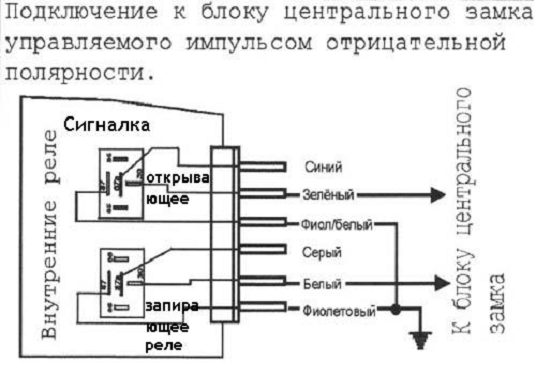 Control of central locking by supply of “mass”
Control of central locking by supply of “mass” In our case, the green and white cords coming from the signaling unit will be required, as indicated in the diagram. However, they will not be the only ones needed. We will connect the relay contacts to breaks in the standard wiring. This means there will be not 2, but 4 cords.
Connection diagram for VAZ central locker
Take another look at the diagram published in the first chapter. We will connect the relay to the gap in the white and brown wires going from the microswitch to the central lock control unit. And it is obvious that it is easier to break these wires near the 8-pin connector. The same one shown at the beginning.
To avoid any questions, we will show you what should happen as a result:
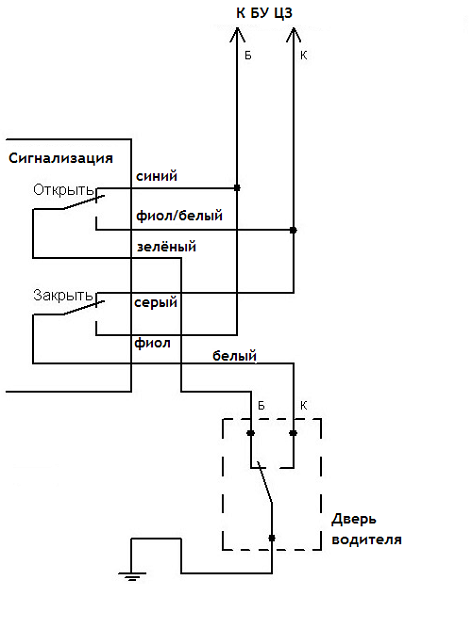 Connection diagram, central lock VAZ
Connection diagram, central lock VAZ
The common contacts are connected to the wires coming out of the microphone. The white cord continues with the brown wire coming from the door, and so on. Normally closed contacts are also used, along with normally open ones. These are the features of connecting to the VAZ central locking system.
An approximate sequence of actions performed by the installer:
- Make and lay a 4-core cable running from the signaling unit to the 8-pin connector;
- Connect the cable on the side of the alarm unit (see the last diagram);
- Near the 8-pin connector, disconnect the white and brown wires coming from the microswitch (pins 5 and 7). The main thing is not to confuse them with the wires going to the triangular connector “C”;
- Make connections to the broken wires, white and brown. That's all.
We have given this sequence to emphasize once again that the relays are switched on between the microphone and the central lock control unit. There is no need to connect any additional devices. As a result, the alarm system will be able to control the state of the locks.
Remember that installation is performed by removing the negative terminal from the battery.
All wires added to the car structure must be protected (use heat-resistant tubes or electrical tape). Twisting is not the worst method to connect two wires. But it's even better to use soldering.
It would seem that if a person has experience working with electrical equipment, he can do everything according to the instructions given. As a result, if no mistakes are made, you may encounter an interesting phenomenon. Instead of closing, there will be a short-term locking followed by opening. And vice versa. What to do in this case?
Take a look at what exactly may be present in some of the configurations:
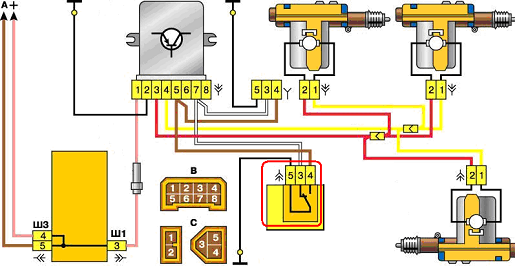 Cheaper - no driver actuator
Cheaper - no driver actuator The driver's door may not have an actuator. And then, it is useless to connect the signaling system to the control unit. There is no actuator, which means there is no one to close or open the door and move the microphone lever. Let's say the locks are closed, and then we remove ground from the brown wire and we get the following: the white wire is on ground, unlocking occurs.
We note the following: installation can only be carried out when you are sure that there is an actuator in the driver's door.
There were configurations where only a microswitch was installed. There is no need for arrogance here - adding an actuator will be difficult, since standard wiring must go to it. As you understand, it may not be available from the factory. And it’s unclear what to do then.
There remains one unanswered question - where exactly the central locking control unit is located. In these VAZ models, if there is a central locking system, then there is also a control unit. And it is located under the torpedo cover, next to the driver, on the right:
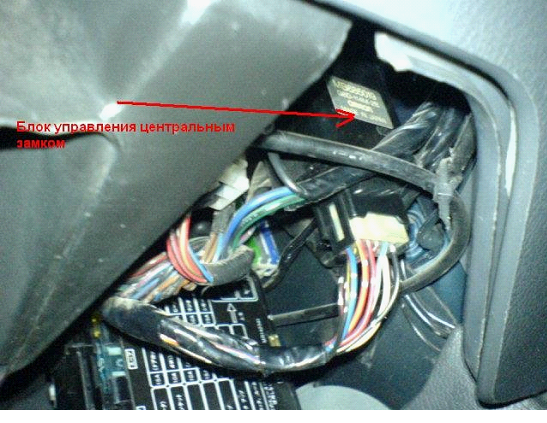 VAZ-2110, BU TsZ
VAZ-2110, BU TsZ We remove the “beard” of the torpedo and look at what is on the upper right. On the same plane with the radio connector, two boxes are attached - the one we need, as well as the immobilizer (if there is one).
We would be lying if we did not say that in reality there is another option for installing the alarm. Standardly, only two are used for actuators power cables. Having a power outlet equipped with a fuse, these cables are connected directly to the alarm relay. This option, as you might guess, is not recommended. Imagine what would happen if the alarm system broke. The central lock must remain, but in this case this will not be done. Happy connection!
Installation of the VAZ-2110 lock actuator
You begin to appreciate many things after they are gone. The same applies to the additional options of the VAZ 2110. Central locking (CL), for example, you can not notice as long as it works properly or you can do without it altogether. But you quickly get used to good things, don’t you? Therefore, when something that provides us with a comfortable ride fails, you immediately begin to rush around in search of answers “how to fix it.”
VAZ cars are not least good for their high maintainability. Whenever something happens to your iron horse, you can almost certainly solve the problem yourself without the help of specialists at a service station. “Ten” was no exception in this regard.
As for the central locking system specifically on Lada 110 cars, this is really a rich topic for discussion. Ignorance of elementary circuits and the operating principle of the unit can confuse many motorists. However, servicing the mechanism is quite simple. And given the enviable frequency of its failure, it turns out that knowing “how” is simply vital.
What is the central locking on the VAZ 2110?
The purpose of this type of device is to centrally control the automatic mechanism for opening and closing all doors in the car at once. This is especially convenient for working in conjunction with an alarm system and when operating a car in general. However, the reliability of the operation of the central locking system should definitely be checked every time by moving the handles of all four doors before going about your business for a long time, since the actuator can often fail and one of the doors may remain unlocked.
Structurally, the VAZ 2110 central lock consists of the following elements:
- electronic transistor control unit;
- gearmotor actuators, also known as activators (one for each door);
- a limit switch that determines the current state of the door (open or closed);
- electrical wiring and other installation elements.

Why the central locking on the VAZ 2110 does not work correctly
The problem of improper operation of the actuator is not at all uncommon for cars in the domestic automobile industry. Despite the fact that there are a number of reasons for the failure of mechanism parts, the principle of operation automatic system closing doors is quite simple, and malfunctions are very typical in their total mass. This means that any motorist can deal with them.
You don’t have to grab your head and run to the workshop in search of a qualified specialist. Thanks to the diagnostic recommendations below, you yourself are very likely to become one. If, for some reason, you don’t want to get your hands dirty, at least no one else will dare to mess with you. And this, you see, also costs a lot.
Problems in the operation of the activator electric drive
The central locking actuator is quite fragile and does not tolerate overload. The activator body, made of plastic, can easily melt if the frequency of door closing is excessively high. The duration of the control pulse also plays an equally important role. Try to always remember about the extreme fragility of the activator and not to load it during operation.
It is easy to guess that the activator is located in each individual door of the car. If the body of one of them melts due to overheating of the electric drive commutator, this becomes the cause of many problems:
- the activator on individual doors stops functioning;
- Constant overloads in a jammed electric drive cause the fuse to fail.
The actuator mechanism is entirely made of plastic. Gears can easily wear out and break during operation, or melt when the commutator overheats. As a result, when the central locking operates, characteristic creaking sounds are heard - a sure sign of imminent failure of the activators. Likewise, if the gearbox of the mechanism is humming, but the doors do not open or close.
Malfunctions of this kind can also be associated with all sorts of defects in the gearmotor and its traction. If you have recently replaced your central locking system, the reason may be that it was installed incorrectly. The mechanism may also be incorrectly adjusted or the fastening may be damaged. In any case, the door trim should be removed and checked visually.
Problem in the operation of the central locking electrical circuit on VAZ cars
First of possible problems flows smoothly from those mentioned in the previous section. Overload in the operation of activators leads to an increase in the operating current in the supply circuit above the rated value. As a result, the fuse blows and the central locking of the VAZ 2110 simply “dies”.
It is by checking the fuse that the diagnosis of central locking malfunctions begins. By the way, it is located in a very specific place and it is not easy to find it right away even if you know where to look. In order to get to it, you will need to fold back the central panel with the fuses and dig into the entire wiring harness in the niche that opens behind it. The “comrade” you need is packaged in a special plastic cup and connected to the pink wire.
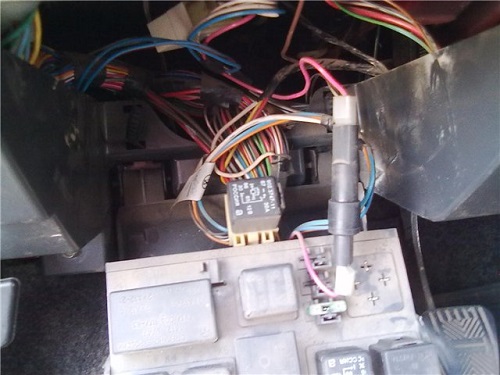
Another very common and obvious problem is the central locking plug connector. It is located in the most unfavorable place for this in the interior body, under the foot mat. A large amount of moisture and dirt inevitably gets there. Electrical contacts are intensively oxidized. As a result, the power supply circuit involuntarily breaks at the point where the plug connector is connected.
Problem with the operation of the VAZ-2110 central locking control unit
Electronics, of course, are reliable things. Modern control modules for the central locking VAZ 2110 are assembled using a transistor control circuit. This eliminates their mechanical wear. The shelf life of key components is measured in tens of years. The control unit is located under plastic cover torpedoes on the right side of the driver's seat.
However, power transistors can easily fail when the activators are overloaded and the collector is short-circuited. It may even happen that the signal from the control unit will constantly be sent to the lock drive if the transistor is broken. Otherwise, it will simply not turn on.
Checking the control unit is extremely simple. The voltage from the negative terminal of the battery, or directly from the pink wire supplying the control unit, is supplied to the contacts of the gearmotor (activator) in series to the red and yellow conductors. All of the above contacts can be found directly on the eight-pin connector of the control unit.
Central locking, or “CZ” as it is briefly called, is a necessary and essential thing for any car, allowing the owner to open and close any door in the car with just one movement of the hand. However, it happens that this system ceases to function completely, or its individual parts do not work properly.
There are reasons why one or another part of the central lock may fail, and we will discuss each in detail below.
The central locking does not work: signs of malfunction and causes of their occurrence
It happens that when the central lock located on the driver's door is closed, no action occurs on the other doors. However, as soon as you move it a little, the doors immediately closed. It is immediately clear that the problem here is the presence of malfunctions in the central locking and several reasons contribute to this.
Among all possible reasons All the most important faults can be identified.
No contact in the drive
With such a malfunction, the contacts inside the control drive do not close the necessary contacts in time. This happens for several reasons:
When such problems occur in the operation of the central locking, first of all you need to make sure that the button is lowered to the very end. If for some reason this does not happen, first inspect the casing for burrs, and then inspect the rod for its even and accurate position.
Fuse blown
If manipulations with the central locking rod do not bring any results, and they do not react in any way to either opening or locking, then first of all you need to check its electrical circuit, and specifically the fuse. Because on the central lock it can fail not only when short circuit in the circuit, but also from the slightest overload.
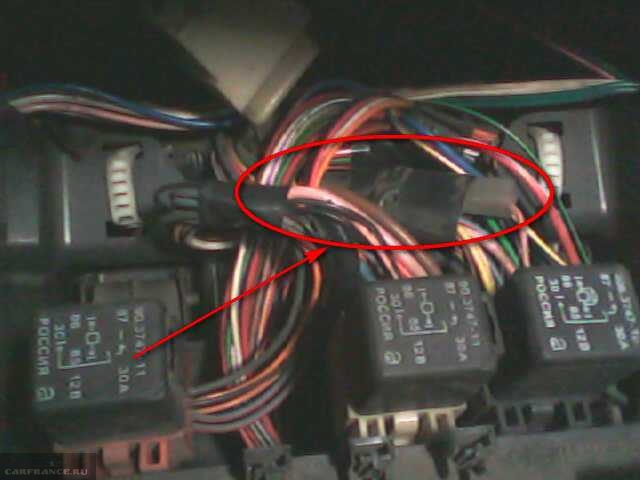
The central locking fuse is indicated by a marker.
Overload occurs most often from insufficient position of the rods, as well as lubrication in them during winter operation of the car.
The central locking wires are broken
Broken wires are not the main reason, but one of the reasons for the failure of the central locking system. The main reason for this is the break in the wires in those places where they bear the greatest load. Such a place is definitely the passage of the corrugation from the side of the pillar and the driver's door. And since it is the driver’s door that is most often opened in any car, it receives most of the load.
- It is quite easy to identify such a malfunction; you just need to release one of the ends of the corrugation through which the wires pass into the door and pull one of the five central locking wires. As a rule, they are connected into one bundle, or go next to each other.
- After carrying out such manipulations, a wire that is torn or interrupted will easily give way among the general heap.
- If you are absolutely sure that a particular circuit is faulty, replacing it will not be difficult by tapping the right wire and further insulation using electrical tape.
- When the wires are broken or torn in other places, the fault can only be found by testing the circuit with a multimeter.
Block burned out
Another reason why the central lock may fail is a burnout of the central locking unit. And in order to diagnose it, you need to use the above-mentioned multimeter and determine the presence of voltage at the contacts of the block.

This is what the immobilizer and central locking unit look like behind the instrument panel.
Please note that during diagnostics it is necessary to operate the lock in the driver's door so that impulses are sent from it to the main unit.
The central locking activator is faulty
And the last reason why the central locking refuses to work is the failure of the activator on the central drive. It can fail both for mechanical reasons, due to wear of rubbing parts, and due to exposure to external factors moisture and corrosion.
If the activator itself breaks down, it is necessary to replace the electric drive with a new one and replace it. Pay attention to the fact that the drive must have five wires of different colors.
The principle of operation of the central lock on the VAZ-2112
The central lock, which operates from the driver's door drive of the VAZ-2112, works as follows:
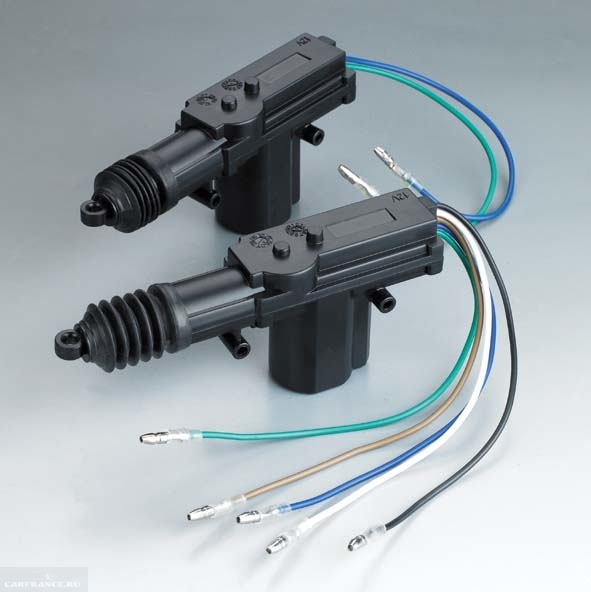
When the lock closes, the rod on the driver's door moves down, thereby closing certain contacts on the electric drive. From these actions, the central locking unit receives signals and transmits commands to the drives of all other door locks. Their discovery occurs in the same way.
Cars produced in the 21st century are very technologically advanced and safety-conscious. They include many devices for the protection and comfort of the car owner. The domestic auto industry is trying to keep up to the best of its ability - this is how a central lock appeared in the VAZ 2109 and 2110.
Additional option – is it worth ordering?
The presence of a central lock in a VAZ car refers to additional options, and even then, if we talk about cars produced after 2000. However, in VAZ 2109 models deprived of this advantage, it is not difficult to install it.
The main purpose of the VAZ 2109 central lock is automatic opening and closing all car doors at the same time. The central locking can be controlled using an alarm remote control that interacts with the system, as well as using a key. The central locking mechanism consists of several sensors that are located in the door envelopes, and circuit breakers. This entire system is interconnected and looped into the vehicle's power supply.
Installing a central lock - car upgrade
If you are interested in such a device, you can install it yourself at home. You can buy central locking for the VAZ 2109 at almost any auto store. They are the same type of design, so the lock from other VAZ cars will also work. For installation, in addition to the lock, you will need several screwdrivers and keys, as well as desire and patience.
Before starting work, you need to disconnect the terminals from the car battery, since installing the lock requires connecting the power supply. After this, you can begin to remove the cards with the casing. During the removal process, the latches that hold them in place may break, so prepare new ones in advance.

Next you need to choose the right place for. It is worth considering the peculiarity of moving the glass mechanism. In rare cases, you may need to purchase additional mounts for the car envelope. The central lock is attached to self-tapping screws and bolts with nuts. Basically, the factory provides a place for installing a lock, and there are also special electrical chips for connecting it.
If there are no such chips in the envelope of your VAZ 2109, then you will need to extend the wiring to the on-board computer control unit. It is located inside the car under the stove shaft. Connecting the power supply correctly will not be difficult for you, because all the chips are universal. A similar installation procedure must be done with the rest of the car cards. Wiring from locks rear doors It’s best to let it go over the thresholds of the car.
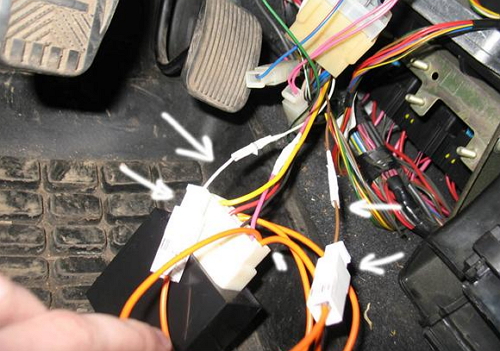
After installing the central locking mechanism, make sure that all doors operate correctly. It is very important that the lock bars move freely and do not interfere with the opening of the main lock handle, as well as the lowering of the car window. During installation everything metal connections needs to be lubricated. And only after that proceed to reassembling the cards with the casing.
Central locking breakdown - we repair it ourselves!
Quite often it happens that the system fails to work - if you are the owner of a domestic car, you are no stranger to breakdowns. This may be a partial breakdown, which in some cases requires cleaning the mechanism from dust or more accurately aligning the lock mounting rods, or minor failures in the power supply system. Sometimes there is a complete failure of the entire device, which requires replacement of some elements of the mechanism.
Often, central locking sensors fail and are easy to replace. Since the lock is directly connected to the car alarm, in our case it is necessary to start the check with it. Try opening and closing the driver's door lock with the key. If the central locking system works, then the problem is with the alarm. If there is no alarm in your car, then proceed immediately to checking the entire lock system.
The main cause of failure in the central locking mechanism is a device called the activator.
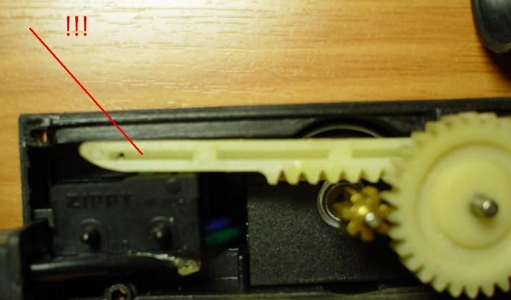
It is installed in the front doors of the car. Its main action is to send an electrical signal to the remaining doors to open or close them. When the activators are triggered, the signal is sent to the central board, which contains fuses. Although they fail quite rarely, they also need to be checked.
Additional fuses are located in the car envelope itself, near each mechanism with a rod. If the lock does not work on exactly one door, then the problem is located there. To fix it you will need a new fuse and a set of tools. Very often, VAZ 2109 owners come to a different solution and connect the wires directly, but this is not recommended, because in the future the entire central locking system may completely fail.
The central locking mechanism is designed in such a way that if the activator in the driver's door envelope breaks down, the rest will also not work. If you have a problem with the manual door opening button, then look for the reasons in the violation of the fixation of the activator rod fastening.
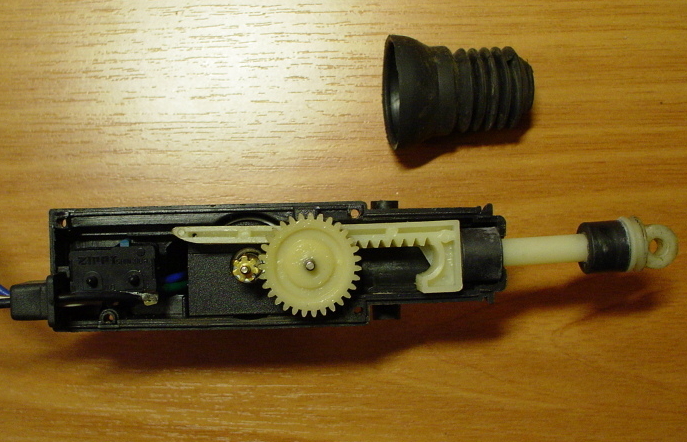
When connecting an electrical circuit, it is best to make the VAZ 2110 work when you turn the key in the ignition. This will keep you safe while traveling. To make this type of connection, you must carefully read the installation instructions. If necessary, you should call an electrician for help or carry out the installation at a specialized car service center.





